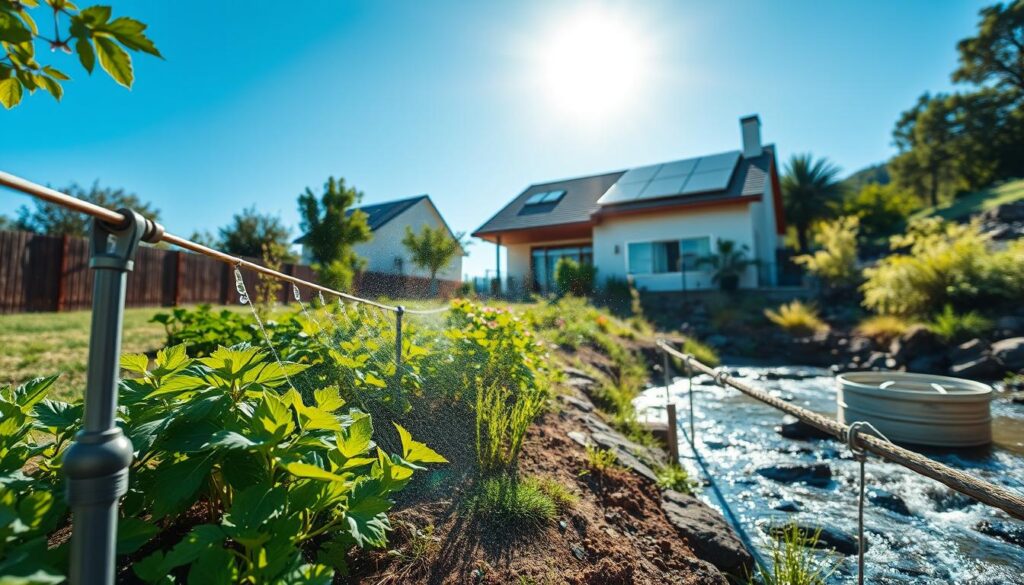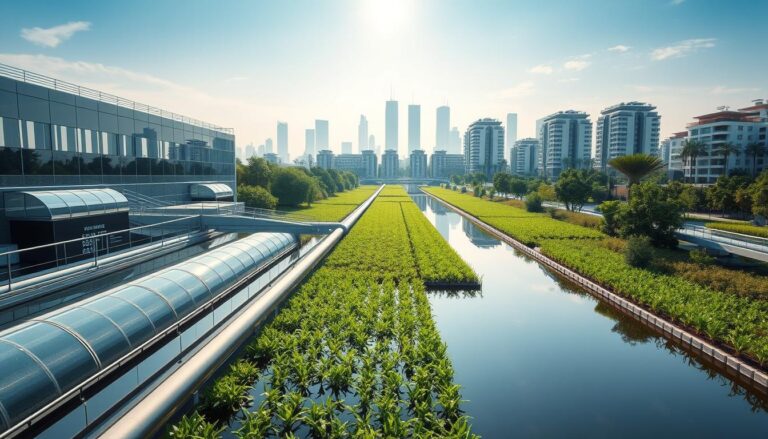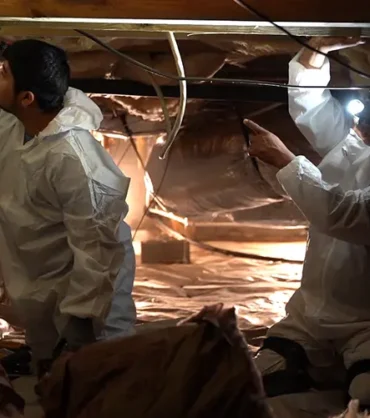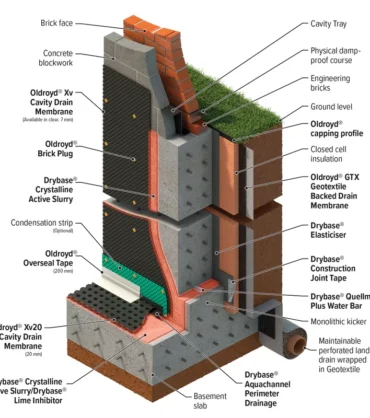Did you know a single leaky faucet can waste over 3,000 gallons of water annually? That’s enough to fill a small swimming pool! For families, the stakes are even higher: households use up to 400 gallons daily, with nearly a third disappearing down bathroom drains. In drier regions, outdoor irrigation alone guzzles 60% of home water supplies.
These numbers aren’t just eye-opening—they’re a wake-up call. Over 2.5 billion people face severe water stress globally, and climate change is tightening the squeeze. But here’s the good news: small changes create big waves. Fixing leaks, upgrading fixtures, and rethinking routines can slash waste while lowering bills.
We’re not just talking about drips and sprinklers. Smart practices protect our shared resources and prepare communities for unpredictable weather patterns. From tech innovations to simple habit shifts, every action matters in safeguarding this irreplaceable asset.
Key Takeaways
- Households use 400 gallons daily, with toilets consuming 27% of indoor water
- Outdoor watering accounts for 60% of home use in dry climates
- Minor fixes like leak repairs can save thousands of gallons yearly
- Water scarcity impacts 2.5 billion people worldwide
- Climate change intensifies the need for smarter resource strategies
Understanding Efficiency in Water Management
What if we told you the way we measure progress in resource stewardship has changed? Let’s start by decoding two critical concepts that shape modern approaches.
Defining Water Use Efficiency
Water use efficiency (WUE) acts like a report card for how well we utilize this resource. Imagine it as a math equation: beneficial outcomes ÷ total withdrawal. Higher scores mean better results with less waste—think of crops yielding more per gallon or factories producing goods using fewer resources.
The Difference Between Water Efficiency and Water Conservation
While these terms often get mixed up, they play distinct roles:
- Water efficiency upgrades systems (like smart irrigation or low-flow fixtures)
- Water conservation changes habits (shorter showers, drought-resistant landscaping)
Tech-driven solutions help us do more with less, while mindful practices encourage smarter consumption patterns. Together, they form a powerful tag team against scarcity. Cities combining efficient infrastructure with public education programs, for example, see faster results than those focusing on just one approach.
Ready to put these ideas into action? The next sections will show how homes, farms, and cities are already making waves with smart strategies.
Exploring Water Use Efficiency and Conservation Strategies
Want to shrink your utility bills while protecting local ecosystems? Let’s dive into actionable methods that deliver measurable results. These approaches blend technology with everyday awareness to tackle waste at its source.

Practical Tips for Reducing Water Waste
Start by hunting down leaks—a dripping faucet loses enough water weekly to fill three bathtubs. Upgrade showerheads and toilets to EPA-certified models that cut consumption by 20-60% without sacrificing performance. Front-loading washing machines use 40% less than top-loaders.
Outdoor spaces offer prime savings opportunities. Swap traditional sprinklers for drip irrigation systems that target plant roots directly. Pair them with moisture sensors to prevent overwatering. Did you know native plants need 50% less water than grass lawns?
| Area | Strategy | Annual Savings |
|---|---|---|
| Indoor | Low-flow fixtures | 13,000 gallons |
| Outdoor | Smart irrigation | 15,000 gallons |
| Appliances | ENERGY STAR models | 8,000 gallons |
Small daily choices add up fast. Turn off taps while brushing teeth (saves 4 gallons daily) and run dishwashers only when full. Collect rainwater in barrels for garden use—it’s free and chlorine-free!
Transforming Agriculture with Efficient Irrigation Systems
Imagine feeding crops with surgical precision instead of flooding entire fields. Farms across America are adopting smarter methods that boost yields while protecting resources. Let’s explore how these breakthroughs work.
Innovative Irrigation Techniques
Modern farms now use targeted delivery systems that act like IV drips for plants. Drip lines bring hydration straight to roots, cutting evaporation by up to 60%. Pair these with soil sensors, and you’ve got a dynamic duo:
- Real-time moisture tracking prevents overwatering
- Automated systems activate only when needed
- Weather data integration adjusts schedules
California almond growers report 30% less water use after installing these tech upgrades. That’s enough to supply 45,000 homes annually!
Crop-Specific Water Needs
Not all plants drink the same. Drought-resistant corn varieties thrive with 20% less hydration than traditional types. Smart farmers match methods to their harvest:
- Cotton benefits from subsurface drip lines
- Wheat fields gain from moisture-retaining mulch
- Orchards prosper with micro-spray systems
Texas rice farmers combining these strategies now produce 15% more grain per gallon. As one grower told us: “It’s like giving each plant its personal hydration coach.”
Urban Water Conservation and Smart Infrastructure
Cities hold the key to smarter resource use through innovative upgrades and everyday tech. Let’s explore how modern tools help urban dwellers cut waste while maintaining convenience.
Implementing Low-Flow Fixtures and Rainwater Harvesting
Upgrading bathroom fixtures creates instant savings without lifestyle changes. Low-flow showerheads now deliver spa-like pressure using 40% less resources. Pair them with aerated faucets to save 700 gallons yearly per household – equivalent to 45 bathtubs!
Rain barrels turn stormwater into free irrigation. Modern systems go further:
- Underground tanks store 1,000+ gallons for dry seasons
- Filter setups make harvested rain safe for car washing
- Smart controllers prioritize stored water before tapping mains
Smart Metering and Leak Detection
Hidden leaks drain budgets silently. Advanced sensors now spot problems before they escalate:
- Real-time usage dashboards show hourly consumption
- Automatic shutoff valves block major leaks instantly
- Mobile alerts notify users of abnormal flow patterns
Phoenix apartment complexes using these tools reduced losses by 18% in six months. As one manager shared: “We caught a broken pipe within minutes – saved 10,000 gallons that day alone.”
Innovative Technologies and Solutions for Water Management
What if your shower could alert you to plumbing issues before they flood your basement? Cutting-edge tools are transforming how we protect this vital resource. Let’s explore breakthroughs merging digital smarts with infrastructure upgrades.
Adopting Artificial Intelligence in Water Systems
AI acts like a detective for hidden problems. Special algorithms analyze flow patterns to spot leaks 300% faster than manual checks. One California utility reduced losses by 22% using these systems – that’s 18 million gallons saved annually!
Groundwater mapping gets smarter too. Neural networks identify:
- Critical ecosystems needing protection
- Optimal well placement for agriculture
- Pollution migration paths
Advanced Infrastructure and Water Recycling
Modern treatment plants now turn laundry runoff into lawn hydration. Greywater systems can slash household freshwater use by 40%. Industrial sites take it further:
- Membrane filters purify manufacturing wastewater
- Closed-loop processes reuse 90% of processing liquids
- Smart sensors optimize chemical dosing
Arizona’s largest chip factory recycled 650 million gallons last year. Their manager notes: “We’re growing tech without draining reservoirs.”
Leveraging Policies and Regulations for Sustainable Practices
How do we turn good intentions into lasting results? Strategic rules and rewards guide communities toward responsible stewardship. Let’s explore how smart frameworks create win-win scenarios for people and ecosystems. Incentives and Standards
Forward-thinking programs make conservation accessible. Many states offer rebates up to $500 for installing EPA-approved fixtures. Businesses adopting recycling systems often qualify for tax credits covering 30% of costs.
Mandatory standards ensure fair access during shortages. California’s urban usage limits saved 1.2 million acre-feet during recent droughts—enough for 2.4 million households annually. Industrial permits now require closed-loop cooling systems that reuse 85% of resources.
Effective Water Rights Management
Ownership rules balance competing needs. The table below shows how different systems operate:
| System | Key Rule | Common Regions | Environmental Impact |
|---|---|---|---|
| Prior Appropriation | First users keep priority | Western states | Encourages storage projects |
| Riparian Rights | Landowners near sources | Eastern states | Protects natural flows |
Modern planning integrates these models with climate forecasts. Arizona’s 100-year resource blueprint combines usage caps with aquifer recharge projects. Developers in Texas now incorporate rainwater harvesting into all new commercial sites.
By aligning policies with local needs, we build resilient communities ready for tomorrow’s challenges. As one Denver official noted: “Good rules don’t restrict—they redirect energy toward smarter solutions.”
Addressing Climate Change Impacts on Our Water Resources
How can communities thrive when weather extremes become the new normal? Over 2 billion people already face water stress daily, with climate change intensifying droughts and floods alike. Dry regions covering 41% of Earth’s surface—home to 2.5 billion residents—now battle shrinking supplies and erratic rainfall patterns.
Building Resilience Through Dual Approaches
The 2022 climate disasters proved we need smarter systems. Drought-prone areas like the Southwest U.S. now combine underground storage with solar-powered desalination plants. Flood zones use permeable pavements and emergency drainage networks to redirect excess rainfall into aquifers.
| Challenge | Solution | Benefit |
|---|---|---|
| Droughts | AI-powered usage tracking | 30% supply optimization |
| Floods | Modular barrier systems | 85% infrastructure protection |
| Both | Community early-warning apps | 50% faster response times |
Urban planners now design parks that double as flood basins during storms. California’s recent projects store enough stormwater to hydrate 500,000 acres of farmland annually. As one engineer noted: “We’re not just surviving climate shifts—we’re adapting ecosystems to thrive within them.”
These innovations turn crises into catalysts. By pairing ancient wisdom with modern tech, we’re rewriting the rules of resource stewardship for our changing world.
Connect With Our 24/7 Support Center for Water Management Solutions
Need expert guidance to optimize your systems? Our team stands ready day and night to help you navigate challenges and implement effective strategies. Whether you’re upgrading infrastructure or adjusting daily routines, we provide tailored assistance for homes and businesses. our hotline for immediate answers to urgent questions or complex technical issues. Our specialists handle everything from leak diagnostics to system redesigns. 24/7 availability means help arrives when you need it most – during midnight pipe bursts or weekend irrigation emergencies.
Our Office Locations
Visit us at five convenient Mid-Atlantic locations for in-person consultations. Our technicians serve these primary regions:
| City | Address | Service Areas |
|---|---|---|
| Washington DC | 2315 Wisconsin Ave NW | Residential & Commercial |
| Rockville MD | 330 N Stonestreet Ave, Unit S | Municipal Systems |
| Ashburn VA | 44121 Leesburg Pike Unit 170 | Industrial Solutions |
Email info@dmvwp.com for personalized consumption reduction plans or project quotes. Attach photos of your current setup for faster troubleshooting. We respond to all messages within 2 business hours – often sooner!
From Maryland suburbs to Virginia farmlands, our local experts understand regional needs. “We don’t just fix problems – we build lasting partnerships,” says lead technician Maria Gonzalez. Let’s work together to protect this vital resource for future generations.
Conclusion
We’ve reached a turning point where smarter practices meet cutting-edge innovation. The European Commission reveals tech upgrades alone could boost water use efficiency by 40% – proving smarter systems aren’t just possible, but profitable. Businesses adopting these methods see returns through lower costs and stronger community ties.
Balancing technology with thoughtful policies creates lasting change. From drought-resistant crops to AI-powered leak detection, every advancement strengthens our shared resources. Cities blending infrastructure upgrades with public education show how teamwork tackles water stress effectively.
Our future depends on choices made today. Simple habit shifts paired with modern tools form an unstoppable force against scarcity. Let’s keep building solutions that honor both nature’s limits and human ingenuity – because when we protect this vital resource, everyone thrives.
FAQ
What’s the difference between water efficiency and conservation?
Water efficiency focuses on optimizing use through technology or practices (like drip irrigation), while conservation emphasizes reducing overall consumption through behavioral changes, such as shorter showers or fixing leaks.
How can households cut down on waste?
Simple steps like installing low-flow showerheads, repairing dripping faucets, and using smart meters to track usage help reduce waste. Rain barrels for outdoor watering also make a big difference!
What irrigation methods work best for farms?
Drip systems deliver water directly to plant roots, minimizing evaporation. Soil moisture sensors and scheduling based on crop needs also ensure resources aren’t overused.
Can AI really improve how we manage resources?
Absolutely! AI analyzes data to predict demand, detect leaks in real time, and optimize distribution. For example, it can adjust pumping schedules to match usage patterns, saving energy and water.
Are there incentives for upgrading to efficient systems?
Many states offer rebates for installing low-flow fixtures or rainwater harvesting setups. Federal programs sometimes provide tax credits for sustainable infrastructure projects.
How does climate change impact planning?
Rising temperatures and unpredictable rainfall require adaptive strategies. Solutions like expanding reservoirs, recharging groundwater, and recycling wastewater help communities prepare for droughts or floods.
Which crops thrive with less water?
Drought-tolerant varieties like sorghum, millet, and certain legumes require minimal irrigation. Farmers can also rotate crops to maintain soil health and reduce dependency on consistent watering.
Why are smart meters useful for cities?
They provide real-time data on consumption, helping utilities identify leaks faster and encourage residents to adjust habits. This reduces pressure on treatment plants and lowers costs.
How do we get help with a project?
Reach out anytime! Call our team at 1-833-888-2533 or email info@dmvwp.com. We offer 24/7 support for everything from design to troubleshooting.



![[GetPaidStock.com]-680786795b816 [GetPaidStock.com]-680786795b816](https://dmvwp.com/wp-content/uploads/2025/04/GetPaidStock.com-680786795b816-370x418.jpg)

![[GetPaidStock.com]-682c400c87c15 [GetPaidStock.com]-682c400c87c15](https://dmvwp.com/wp-content/uploads/2025/04/GetPaidStock.com-682c400c87c15-370x418.jpg)

![[GetPaidStock.com]-682c413fa898e [GetPaidStock.com]-682c413fa898e](https://dmvwp.com/wp-content/uploads/2025/03/GetPaidStock.com-682c413fa898e-370x418.jpg)